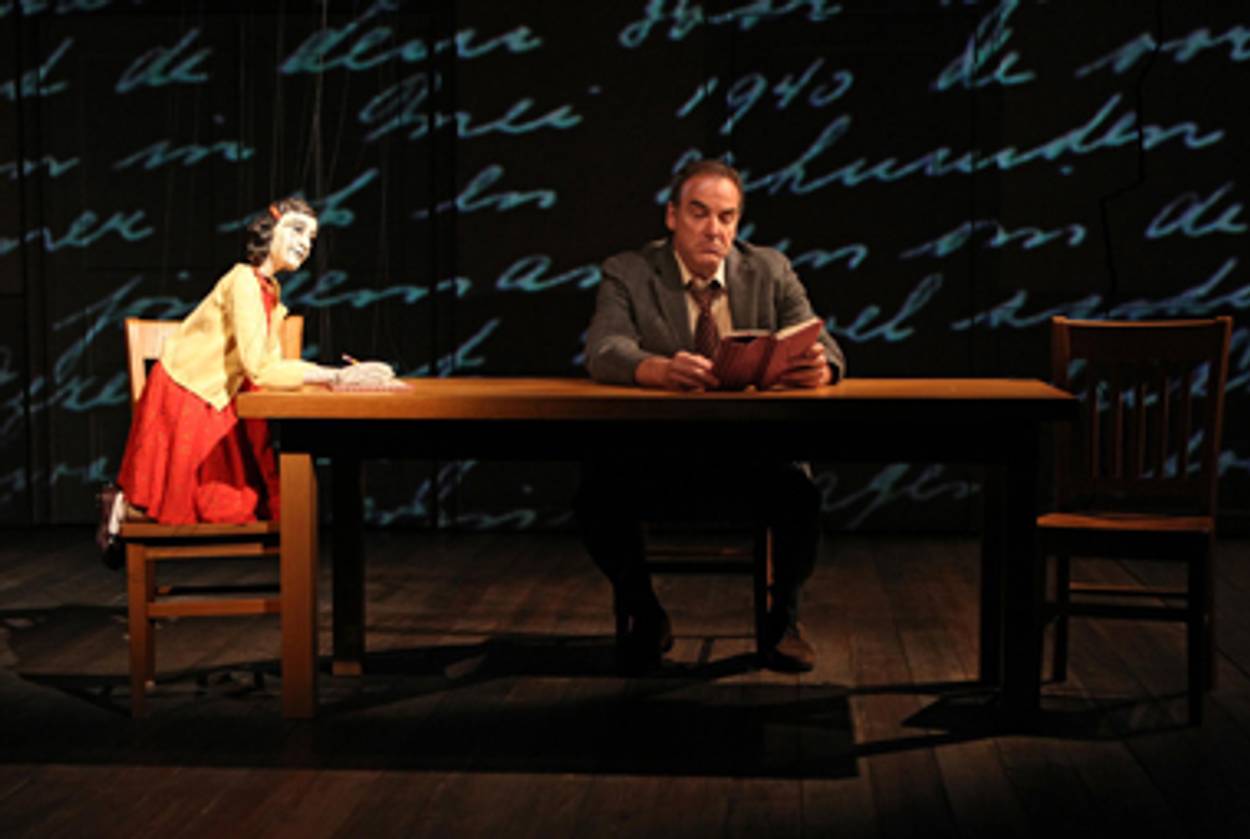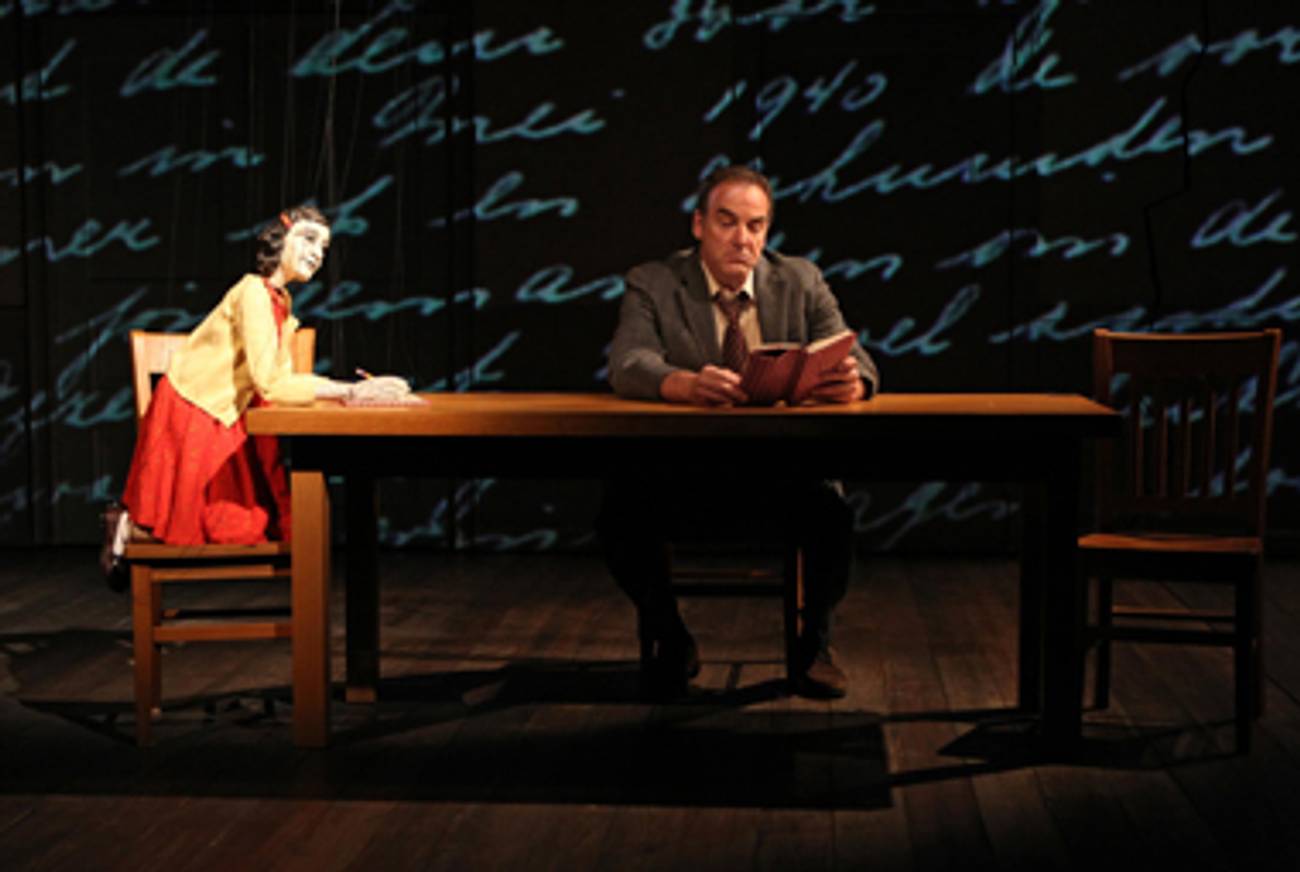Ghost Puppeteer
In Compulsion, now at New York’s Public Theater, Mandy Patinkin portrays a writer whose obsession with Anne Frank drives him to the brink of madness




Who is the audience for Rinne Groff’s play Compulsion, a meta-theatrical take on The Diary of Anne Frank?
At first I thought the play, which stars Mandy Patinkin and in which Anne Frank is played by a marionette, was aimed at my demographic—Baby Boomers—or older, readers of Philip Roth’s The Ghost Writer, Holocaust-worriers, identity-fretters, anti-Semitism seers. I thought it was pitched to people (like me) who had nightmares about the diary as a child.
In fact, I was probably the youngest person in the audience the day I saw Compulsion at the Public Theater, in Manhattan. (The play has already had successful runs at Yale Repertory Theatre and Berkeley Repertory Theatre.)
But the more I thought about it, the more I wondered if Compulsion also seeks a younger audience, an audience less stuck in a particular way of thinking about these subjects. Groff, who is a founder of Elevator Repair Service, the theatrical collective best known for Gatz, an engaging seven-hour staged reading of The Great Gatsby, seems on the surface hardly interested in the story of Anne Frank that the diary tells—that of a young writer entering adulthood in the shadow of the Holocaust. Nor is she that interested in the story of The Ghost Writer, in which Roth’s alter ego Zuckerman imagines that a woman he meets at the home of his mentor is Anne Frank.
In Compulsion, Anne Frank is a marionette precisely because she is no longer and can never be a girl, because she is an artifact and a symbol. She is more of a cloud than a character.
Groff’s real interest seems to be how the diary destroyed the very man responsible for its success. In Compulsion, this man is Sid Silver, a lightly fictionalized version of Meyer Levin (Patinkin), the writer and puppeteer from Chicago who introduced the diary to America, became obsessed with making a dramatic version of it—with being the diary’s puppeteer, so to speak—and descended into paranoia and madness.
Stylistically, though, Compulsion is of our time. It owes a lot to reflexive works like Being John Malkovich and toI Am My Own Wife, the one-person show by Doug Wright about his conversations with a German transvestite. It is probing, cagy, and unresolved—as theater people like to say, up to the audience to make sense of it.
In real life, the fascinating saga of Levin and the diary was, as Francine Prose wrote in Anne Frank: The Book, The Life, The Afterlife, “so rife with betrayal and bad behavior … that at least four books have attempted to explain what happened and why.” Years ago, Groff read a review of the most even-handed of these books—Lawrence Graver’s An Obsession With Anne Frank—in the New York Times Book Review and began to research the story.
It’s easy to see why. In her book, Prose quotes Cynthia Ozick as comparing Levin’s saga to that of Jarndyce and Jarndyce, the lawsuit in Bleak House whose ruinous costs far exceed those of money.
Levin, a writer with a tormented relationship to his own Jewishness, is given a French version of the diary by his young wife after World War II. He becomes determined to get the diary a wider audience. He begins to correspond with Otto Frank, he brings the diary to Doubleday, he tries to help sell it. He is not agenting, exactly—he never accepts money for his efforts—but he does give the book a rave review in the New York Times Book Review. (Prose makes the interesting point that his review made a book that might otherwise have been remaindered a best-seller.)
After it becomes clear that the diary is a commercial property, Doubleday grows increasingly cold to Levin’s suggestion that he write the theatrical adaptation, especially since he does not actually have a formal contract. Levin becomes more belligerent, and lawsuits follow. Levin sees conspiracies, Cold War ones and anti-Semitic ones. He accuses Doubleday of commercializing the diary, of making it less Jewish, of watering it down. He smears writers Doubleday likes.
None of this helped Levin’s cause. After Doubleday was turned down by many writers (including Carson McCullers and Lillian Hellman), two Hollywood hacks did the theatrical adaptation. As some critics pointed out at the time, one of the sins of this adaptation, which ran on Broadway for 717 performances, was to replace the wise, knowing voice of Anne Frank with that of a fluff-brained sock-hopper. The producer wanted the play to make people laugh. For its uplifting ending, the play twists a line from the diary, “I still believe that people are really good at heart” into banality. (Groff uses this line too, to ironic effect.)
Levin did his own dark, serious, possibly unplayable adaptation. He moved to Israel.
This is a good story. And Compulsion, which is also the title of a book by Levin about Leopold and Loeb, asks good questions, some of which have been asked before: Was Levin insane or was he wronged? Who owns an artistic work about the Holocaust? What is the cost of turning such a work into a classic? What is the cost of profiting from it? Who should tell the Jews’ stories? Can others do it?
Yet my first response to this play was frustration. There is an unresolved tension between Groff’s interest in dreams, questions, meta-theater, and realistic acting. Patinkin, for example, plays Silver with an old-fashioned cheery belligerence. From the moment he lurches on stage (greeted by a standing ovation), he is too Jewish. “I’m writing a book about what it means to be a Jew in the world today,” he announces to the horrified Doubleday editors. He might have stepped out of an Arthur Miller play.
A thornier and more unsolvable problem is the limitations of the theater, where it is difficult to layer in complex historical arguments and facts. So you cannot know for example, when Silver rants that a Stalinist conspiracy was responsible for his being denied the adaptation, that this is absurd. In fact, the only thing he was right about was that Doubleday wanted to make money off of Anne Frank.
But Groff gains something from showing scenes inside Silver’s marriage. In one, set on Fire Island, Silver is working on the theatrical adaptation without a contract. His long-suffering wife confronts him. You learn that during their courtship—he was a 40-year-old soldier, and she was 19—he pursued her with all the avidity with which he now pursues Anne Frank. They dance.
There are also satisfying confrontational moments, like when Silver spits in the face of one of the editors. And schticky ones, like when Silver says, “I still love the juice” a Borscht Belt joke on “I love The Jews.” That got laughs.
The moment that redeemed Compulsion for me is one of the least naturalistic in the play. It takes place in Act Three. It is 1966, and the Silvers have fled to Israel to escape Anne Frank. But they can’t. Silver is asleep but he, his wife, and Anne Frank are all in bed together. Silver is speaking Anne Frank’s lines, which heightens the sense of confusion about who is really who here. Silver’s wife is trying to convince Anne to leave the family alone. (She has already tried to kill herself because of her husband’s obsession with Anne.) Anne will only do this if the wife lets her sleep in the bed. Finally, she relents and they snuggle up together.
At that moment, Patinkin gets out of bed and, in a spotlight, sings a haunting song, which I was later told was “Mayn Shtetle Belz.”
Here I thought Compulsion hinted at what it could be about: the search for the invisible lost world. This is not just a historical search—it is about identity. “Mayn Shtetele Belz” represents a tiny fragment of this, of nameless towns and dead Jews, that Silver is driven to recapture through Anne Frank. But his search isn’t just about his own identity; it’s about that enormous world whose energy remains though most of the evidence that it even existed is gone. The diary was one such piece of evidence, and the quest for it—and the examination of his relationship to it—drove Silver into madness.
Rachel Shteir, a professor at the Theatre School of DePaul University, is the author of three books, including, most recently, The Steal: A Cultural History of Shoplifting. She is working on a biography of Betty Friedan for Yale Jewish Lives.
Rachel Shteir, a professor at the Theatre School of DePaul University, is the author of three books, including, most recently, The Steal: A Cultural History of Shoplifting. She is working on a biography of Betty Friedan for Yale Jewish Lives.